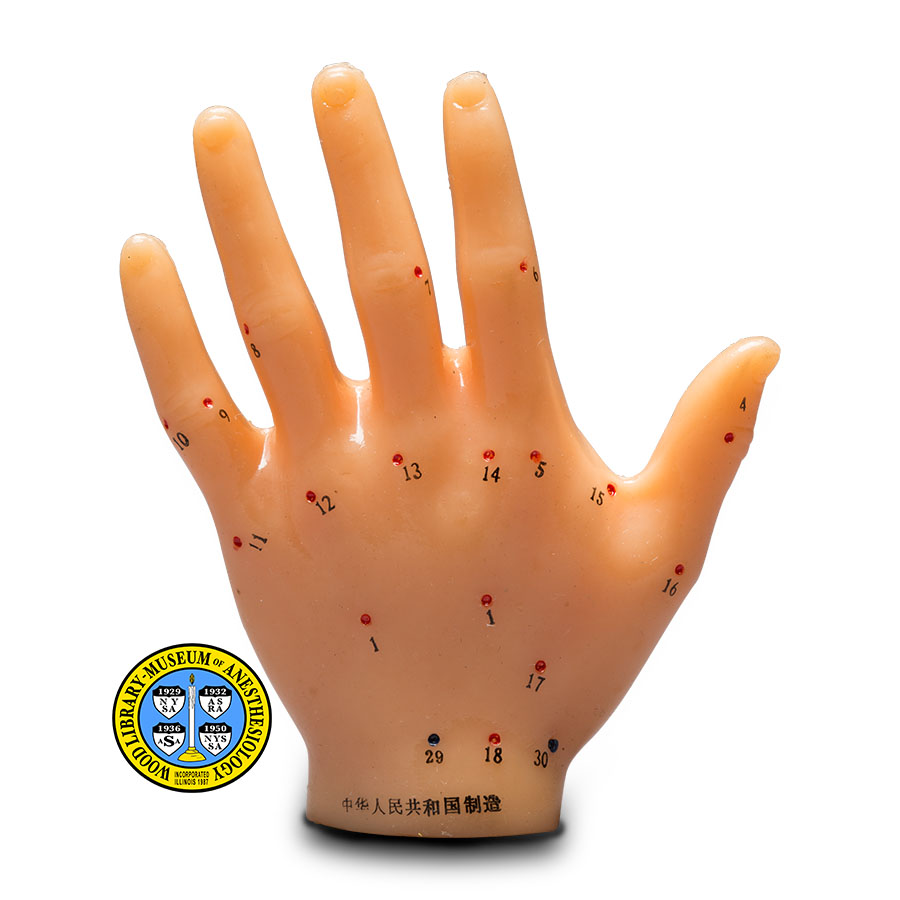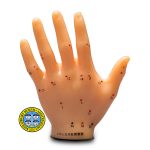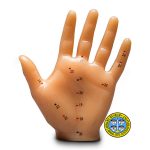Acupuncture Hand Model
The practice of acupuncture is based on the ancient Chinese concept of yin-yang balance. Yin and yang represent the interdependent opposites that exist in everything, and for good health the two must be in balance. According to traditional Chinese medicine, a metaphysical energy called "qi", or “chi”, is believed to circulate throughout the body along invisible channels called meridians. It is thought that stagnation or problems with the flow of "qi" causes a yin-yang imbalance. To restore that balance, the skin is punctured with very fine needles at acupoints. Most acupoints are found along the body’s twelve meridians.
In the 1970s, reports of the use of acupuncture for surgical anesthesia in China received increasing attention in the western popular press and medical journals. This was the beginning of serious study, and debate, of acupuncture by anesthesiologists in the United States. In this country today, anesthesiologists use the technique of acupuncture to treat painful conditions. The plastic teaching models shown here were made for sale to western countries.
Catalog Record: Acupuncture Hand Model Acupuncture models of the hand
Access Key: apnw
Accession No.: 2000-05-20-1
Title: [Plastic acupuncture teaching model: hand].
Publisher: Hong Kong, China : East Wind Medical Instruments Co., Ltd., 1966-2000.
Physical Description: 1 model : plastic ; 7.5 x 6.5 x 1.5 cm.
Subject: Acupuncture Points.
Subject: Acupuncture – education.
Subject: Models, Anatomic.
Note Type: General
Notes: The name of the publisher and the place of publication are identified in the accompanying manual, and by the manufacturer’s logo printed on the base of the object. The first year in the date range is based on the year that the company was founded, according to the Hong Kong Business Directory website. The same Directory indicates that the company was still in business as of the date that the website was accessed. The second year in the date range is the year that the object was donated to the WLM. The object is described from the user’s perspective. The palm is considered the front and the opposite side is considered the back. The bottom is considered the flat base just below the join of the hand and wrist. The top is considered the tip of the second finger.
Note Type: Citation
Notes: Barnes PM, Bloom B, Nahin RL. Complementary and alternative medicine use among adults and children: United States, 2007. National Health Statistics Reports. 2008;12(10):10.
Note Type: Citation
Notes: Carrubba RW, Bowers JZ. The western world’s first detailed treatise on acupuncture: Willem Ten Rhijne’s De Acupunctura. J Hist Med Allied Sci. 1974;29(4):371-398.
Note Type: Citation
Notes: East Wind Medical Instruments Co., Ltd. Hand Model Showing Acupuncture Points. Hong Kong: East Wind Instruments Co., Ltd., [not before 1966 or after 2000].
Note Type: Citation
Notes: Ernst E. The recent history of acupuncture. Am J Med. 2008;121(12):1027-1028.
Note Type: Citation
Notes: Hong Kong Business Directory website.
https://www.hkgbusiness.com/en/company/East-Wind-Medical-Instruments-Company-Limited. Accessed March 13, 2017.
Note Type: Citation
Notes: Shibutani K. Special report: acupuncture conference at Grasslands. NYSSA Sphere. July-August, 1972;24(4):22-26.
Note Type: Citation
Notes: White A, Ernst E. A brief history of acupuncture. Rheumatology. 2004;43(5):662-663.
Note Type: Physical Description
Notes: One acupuncture teaching model of the left human hand; Made of pink or flesh-colored plastic; The hand is
represented with the fingers and thumb spread open, but not stretched; The model stands upright on a flat base just below the join of the hand to the wrist; The underside of this base is marked with the manufacturer’s logo; Both the front and back are marked with dots that indicate the location of acupuncture points; Most of these dots are printed in red, and some are printed in black; All of the dots are accompanied by an Arabic number printed in black;
The Arabic numbers range from “1” to “33”; The front of the wrist is marked in foreign characters, most probably Chinese.
Note Type: Reproduction
Notes: Photographed by Mr. Steve Donisch, November 15, 2016.
Note Type: Acquisition
Notes: Gift of George S. Bause, M.D.
Note Type: Historical
Notes: The Chinese practice of acupuncture is based on the ancient Chinese concept of ‘yin yang’ balance. Yin and yang represent the interdependent opposites that exist in everything, and for good health the two must be in balance. According to traditional Chinese Medicine, a metaphysical energy called “qi”, or “chi”, is believed to circulate throughout the body along invisible channels called meridians. It is thought that stagnation or problems with the flow of “qi” cause a yin yang imbalance. Acupuncture is used to restore that balance. Acupuncture involves puncturing the skin with very fine needles at acupoints. Most acupoints are found along the body’s twelve meridians (Morris, 2011 ; White A, Ernst, 2004).
Long before it became familiar to Europeans, acupuncture spread from China to other areas in Eastern Asia, including Korea and Japan (White & Ernst, 2004). Willem ten Rhijne, a Dutch physician who studied acupuncture for two years in Japan, wrote the first European text on the subject, De Acupunctura, published in 1683 (Carrubba & Bowers, 1974). Surgeon James Morss Churchill wrote the earliest English text on acupuncture, A Treatise on Acupuncturation, in 1823. Acupuncture became popular in the U.S. beginning in the 1970s. A 2007 National Health Interview Survey found that an estimated 3.1 million Americans had used acupuncture in the previous year (Barnes, Bloom & Nahin, 2008). Today it is commonly used as an alternative or complementary therapy for pain.
Research on acupuncture has had a number of limitations, and how researchers and physicians interpret the results of existing research can vary significantly. Some believe the research indicates that pain relief from acupuncture is a reflection of the placebo effect (Ernst, 2008). Others believe that enough data is available to suggest that acupuncture may benefit patients with certain kinds of pain, such as low back pain, neck pain, and tension headaches (Kelly, 2009).
Most agree that more high-quality research is necessary to draw solid conclusions as to the mechanism of action and the efficacy of acupuncture in the management of pain. The Western name for acupuncture is derived from Latin: acus (needle) and pungere (to prick) (Morris, 2011).
Note Type: Exhibition
Notes: Selected for the WLM website.



